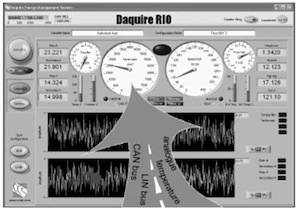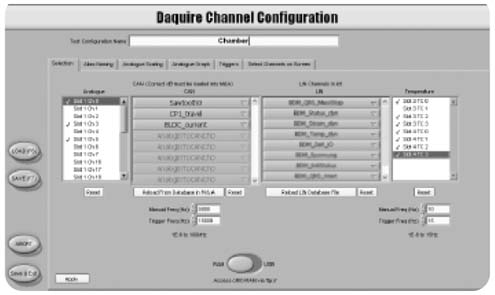In-Vehicle Data Acquisition Daquire RIO for Bentley Motors
Àâòîðû: Paul Riley, MD – Computer Controlled Solutions Limited
Èñòî÷íèê: NIDays08 - Professional Development Conference for Engineers and Scientists. CUSTOMER CASE STUDY BOOKLET.
THE CHALLENGE
Bentley Motors Ltd. required an acquisition system to analyze ECU signals synchronised with electrical measurements to prove out two areas of development in the release of the next luxury vehicle.
The first area was to analyze signal timing of CAN channels compared to system operations. The second area was to analyze the efficiency and losses in the electrical power distribution.
Challenges were in the requirements of:
- High speed acquisition, up to 20 kHz with 32 analogue, 64 CAN and 16 LIN channels
- Precise synchronisation of all channels
- Complete range of low- and high-speed acquisition over time periods of minutes to weeks
- High temperature range, vehicle tested under extreme conditions in a climate chamber
- Simple configuration
Products:
NI cRIO-9014 Controller, 3M Gate 8-Slot Backplane, NI cRIO-9205,
NI cRIO-9229, NI cRIO-9219, NI cRIO-9211/2, NI cRIO-9853,
NI cRIO-9852, and a LIN to CAN Interface
Software: LabVIEW 8.5.1 Professional, LabVIEW FPGA 8.5.1, NI-RIO 2.4.1
Industry:
Automotive – Luxury Cars
THE SOLUTION
CCS Limited used the CompactRIO platform to provide a complete solution to the customer requirements.
The challenges were addressed as follows:
- Programming of the FPGA in LabVIEW allowed for 25 nS accuracy and high-speed collection of all channel data. In particular the National Instruments CAN modules allow for very high data rates in their class.
- CCS experience in good code design and optimisation resulted in a high bandwidth of synchronised data being streamed to solid state memory.
- A clear configuration screen allowed the operator to configure acquisition speeds over a wide range with high-speed triggering settings.
- Accounting for operation within a wide temperature range was solved simply by the use of CompactRIO, a rugged and well designed system ideal for this solution.
- The software was designed fully in LabVIEW for very simple and clear configuration via a laptop.

Bentley Motors required a true multifunction acquisition device covering a range of signal formats. This device needed to synchronise analogue, HS CAN, LS CAN and LIN data at upto 100 kHz per channel.
Computer Controlled Solutions Limited developed a modular system providing high-channel capacities, acquisition rates and synchronisation with a very simple configuration screen at a low market cost.
This system is based around the NI CompactRIO hardware. The advanced acquisition software is developed in NI LabVIEW by Computer Controlled Solutions and given the name Daquire representing its advanced data collection and acquisition qualities.
About Bentley Motors Limited
Located in Crewe, England since 1946 and owned by Volkswagen AG since 1998, Bentley Motors is dedicated to making responsive and powerful Grand Tourers with the stamina to cross continents at pace and drive in refined comfort and style.
About Computer Controlled Solutions Ltd
Formed in 1994, Computer Controlled Solutions has produced many complex test, control and acquisition systems for industry. A National Instruments Alliance Partner since 1994 with two Certified LabVIEW Developers, the company provides advanced LabVIEW solutions based around National Instruments hardware.
In addition to the provision of turnkey solutions to a wide range of industries as seen on the website ccsln.com, the emphasis of our work in the automotive and autosport field has been encapsulated in our Daquire website (daquire.com) which specialises in the FPGA technology from National Instruments.
System Requirements
A system was required to acquire the following:
• Up to 16 analogue voltages monitoring current shunts and
battery voltages.
• Up to 4 high-speed high voltage signals
• Up to 4 high-accuracy microvolt shunt readings
• Up to 64 high- and/or low-speed CAN channels • Up to 64 LIN channels
Acquisition was required in a variety of testing modes, from five second to five weeks duration with immediate triggering over a frequency range of 0.01 Hz to 100 kHz.
All kits had to be relatively small, robust, portable and operate from a 12 V supply.
The data needed to be provided in an NI DIAdem format for further analysis.
With vehicle climate testing, all hardware required an operation temperature range of -40 to +70 °C.
Hardware Details
The CompactRIO platform proved to be ideal for this requirement. Apart from fulfilling all specifications it also resulted in a modular piece of equipment which could be adapted with channel and hardware variations.
In particular:
• With a voltage range of 9-35 V the CompactRIO has no problem
running on standard vehicle batteries.
• Dimensions of the CompactRIO 8-slot system make it very
portable and easy to mount within a vehicle.
• The system has a proven 50 g shock rating making it an ideal
platform for in-vehicle testing.
• The CompactRIO controller and all modules have an extended
operational temperature range of -40 to 70 °C.
Software Design
The software was written completely within LabVIEW 8.5.1 and FPGA toolkit. CCS had completed a similar in-car system with advanced code in the noise, vibration and harshness (NVH) field for vibration analysis of the drive train. Using this experience and proven routines we designed this new system to account for more channels, higher bandwidth and precise synchronisation.
Careful coding was required to ensure a high data bandwidth was achieved with complete synchronisation of signals. Here, being able to write and compile code for an FPGA device within the familiar LabVIEW environment is crucial. No other method of software design and testing could have possibly allowed us to reach the same results within time and within budget. Figure 1 shows the main screen of the monitoring PC attached to the CompactRIO hardware via an Ethernet lead.
The following front end design objectives were met:
- Simple and Flexible: Acquisition is ready from starting up and
connecting a PC.
 Figure 2: Simple channel selection and configuration
Figure 2: Simple channel selection and configuration - Simple to calibrate: Clear displays in the configuration screen allow calibration to be carried out.
- Simple to configure a library of acquisition settings: In the configuration screen (see Figure 2) the operator can clearly choose any analogue- or bus-based signal, set triggering, acquisition rates and choose which parameters to display. Any channel can be displayed in a panel meter, gauge, dial or LED format.
- Well structured and searchable acquired data (TDMS Format): All data is streamed to a USB memory stick or internal memory in a binary format. Once a set of tests is completed the user can then simply batch convert data into a format required by the customer, in this case DIAdem for advanced analysis and comparison of signals.
Results
Matching Bentley’s exacting requirements was achieved. In particular the ease of configuration with little or no training required, the high channel count and high speeds could not be matched by any other product. Is the customer pleased? The second system has been ordered.
A new system is also under development at CCS which is based on the above hardware and requirements with the addition of synchronised GPS.
For more information on this case study, contact: Paul Riley, MD
Computer Controlled Solutions Limited
37 Park Street, Leamington Spa
Warwickshire
CV32 4QN
Tel: +44 1926 430200
paul@ccsln.com
www.daquire.com
www.ccsln.com